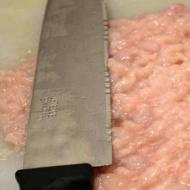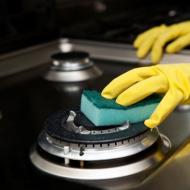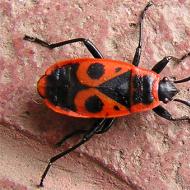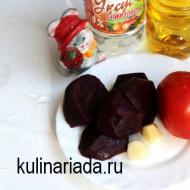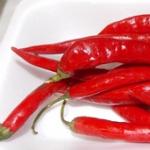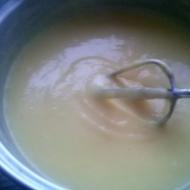
White cabbage kimchi. Kimchi from Beijing cabbage is a world snack, guests literally sweep it off the table
Chimcha (or Kimchi) is a kind of Korean pickles, without which no Korean meal can do. In fact, this dish is an appetizer and is not consumed by itself, and most often comes as an addition to another dish or side dish. The perfect tandem for Koreans is chimcha with rice. This dish can be called the Korean equivalent of our sauerkraut. Here are just Korean cabbage chimcha has a rather specific, unusual taste for us due to the presence of a large amount of garlic and seasonings. At the same time, it remains very useful and will appeal to lovers of sharp little ones. Like many other dishes, chimcha has many cooking options - only in Korea today there are more than a hundred recipes for such cabbage. There she is even the measure of culinary professionalism. Try your hand at this art too.
Chimcha (option number 1)
This Korean chimchi recipe can be called close to classic. Fresh ginger will accentuate the sharpness and piquancy of the cabbage flavor here. Ingredients Required:- cabbage (Peking) - 1000 g;
- red pepper (dry, finely chopped) - 4 tsp.
- salt - 6 tbsp. l
- water (cold and very hot) - 2 l and 1 l respectively
- sugar - 4 tsp.
- ginger, garlic, green onions (finely chopped) - 1 tbsp. l
Chimcha (option number 2)
Fans of keen gastronomic sensations will also delight this “fiery” chimcha, the recipe of which includes another frequent component of Asian cuisine - soy sauce.
For those who know what Chim Chi is and who does not know that it is Korean cabbage, I offer two recipes - for those who like to do "by eye", and for those who like accurate weight ratios.
Calorie per 100 grams about 30 kcal
№1
Ingredients:
Chinese cabbage
salt
ground pepper
garlic
water
Cooking:
We divide Beijing cabbage into leaves, wash it and coat each leaf with salt - we coat it well. Fold in a pot. Leave for 10 hours. After washing the leaves with water from salt, put them in a pot. Next, do the following mass: cut finely-small garlic (take 1–5 cloves for 1 medium cabbage forks), you can push it with a press or in a grinder chopper. Add red ground pepper to garlic (about 1 teaspoon without a slide), and pour a little water to make such a slightly thick mass. Let her stand for 30 minutes. Then we coat each sheet with this mass. All this canoe must be put under the press. Keep in mind that the liquid is allocated well, so initially the piece should be such that this liquid does not spill onto the table. We remove in the refrigerator. You can eat the next day, but it is better that at least a day stood. If in the end it turns out very sharply - then just rinse with water slightly to the desired spicy taste.
№2
1/5 kg Chinese cabbage
5 tablespoons of salt
1 head of garlic
1/2 teaspoon sugar
3 tablespoons of hot pepper
Korean Chimchi cabbage is made very simple:
Cabbage cut into 8 equal parts and sprinkle with salt.
Pour the cabbage with water and put a plate (lid) on top, a load on it. Leave for two days.
Cabbage should be tried. It should not crunch like fresh.
When the cabbage has ceased to crackle and is sufficiently saturated with salt, it should be rinsed well under cold running water, gently squeeze and drain in a colander for 30 minutes.
Then tear off a large leaf of cabbage and try on the salt. If it is unsalted, add more salt.
Pepper pour boiling water to get a thick gruel.
Squeeze garlic into this mush, add sugar and mix.
Cut cabbage into small squares and mix with garlic dressing.
Put the chimchi in the fridge.
Nutritionist's Commentary on Kim Chi (Chim Cha) Recipe
Nutritionist Tishchenko Konstantin
The dish has an average calorie content. Due to the low protein content, it is not conducive to building muscle. Dish should be included in the diet for weight loss.
Kim Chi (Chim Cha) is indicated with a lack of vitamins, trace elements, carbohydrates and obese people. Fresh garlic reduces blood pressure, cholesterol levels, prevents the formation of blood clots in blood vessels, improves immunity. Onions (including sweet varieties) stimulates peristalsis, stimulates appetite, reduces swelling. It is rich in potassium, calcium, magnesium, vitamins A, B, C, PP. Ginger contains up to 3 g% of essential oil and ginergrol, which give it a specific pleasant smell. In diseases of the cardiovascular system, kidney and pancreas, ginger food supplement is not always desirable. Sauerkraut is rich in vitamins C, K, B group, contains potassium, sodium, calcium, iron, phosphorus, sulfur, silicon, zinc, boron, copper. During fermentation, cabbage is also enriched with organic acids (lactic, acetic). Sauerkraut has a tonic, anti-inflammatory, analgesic, bactericidal, anticarcinogenic effect. It promotes digestion, regulates the acid-base balance, normalizes the level of sugar and cholesterol. Therefore, sauerkraut is especially useful in case of metabolic disorders, patients with diabetes, gastritis with low acidity.
Acute diseases and exacerbation of gastrointestinal diseases, liver, pancreas, are contraindications to the use of food.
Korean dishes are distinguished by a very special, unique taste, variety, brightness, special cooking technology and substantial spiciness.
Unsharp Korean dishes are not.
But in our power to regulate this sharpness, customizing to your taste. However, it’s still worth remembering: without spiciness, a Korean salad is not a Korean salad.
I will describe how the famous Chimcha snack is made or, if you like, Korean cabbage.
I read somewhere that the correct name of the snack is not chimcha at all, but kimchi or even kimchi. Perhaps, but we are talking about the cuisine of Koreans in Central Asia, and there they call snacks like that - Chim-cha. I have already mentioned that the cooking of Central Asian Koreans is very different from the peninsular and Far Eastern.
The technologies are similar, but the products are local, which makes it acceptable and attractive for us.
Just imagine, in the 30s they transported, or rather, deported tens or even hundreds of thousands of Koreans from the Far East to Central Asia and threw them into a completely different climate and onto the land, to which a very special approach is needed. Without utensils, without provisions, under the scorching sun ... Witnesses said that they were unhappy at a camp near Tashkent in an open field somewhere from the Kuylyuk district. No roof over your head, nor any kind of support ... And you cannot enter the city, because the special settlers. Yes, local languages practically do not know. So they fed on grass and collected scarce herbs, applying traditional cooking techniques to them. They were cured. And settled down. Not without the help of local, of course. In Uzbekistan, it is not customary to throw people into starvation. Even if they are unknown strangers, who have never been here before.
And Koreans are incredibly hardworking people. Through their work, decency through blood, sweat and tears they managed to survive and earned themselves great respect from the local population. Now, by the way, in Tashkent Kuylyuk mentioned above is the area of compact residence of Koreans. There are special markets and traditions are honored.
So, we are about chim-che. For her, take:
Chinese cabbage - 2 heads;
garlic - 1 head;
ground black pepper;
red pepper;
bay leaf;
salt.
At once I will say that chim-chu can be made from the usual white cabbage. It is possible, but still not worth it. The snack is quite harsh. But Beijing - it is gentle, which gives chim-che a special charm. And the Koreans make it only from Beijing.
Let's start. Wash swings under cold water, wipe off those leaves that have dried out or spoiled. In general, everything is as usual.
Now let's cut the ropes into four parts along.
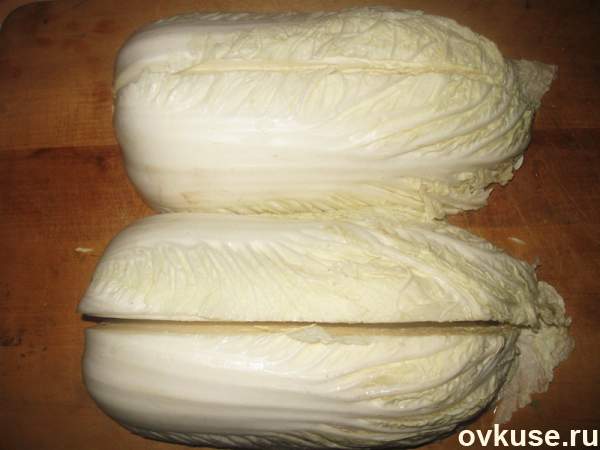
Put them tightly in a suitable container.
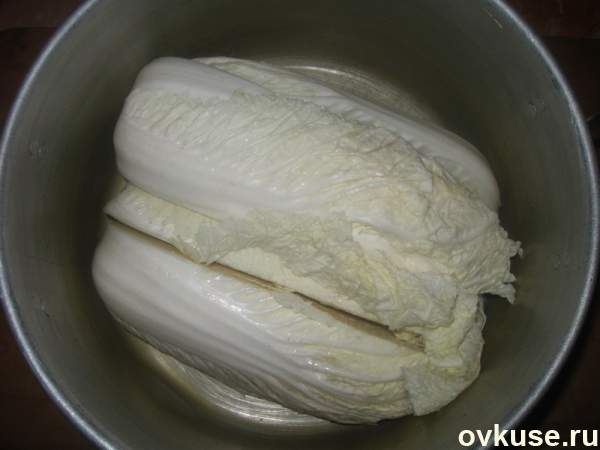
Fill it with salty warm water and press it down. Water should completely cover the cabbage. And put it all in a warm place for two days. Cabbage needs a little sour. I just want to warn you: two days is if the place is really warm. Again, there may be different nuances. Therefore, everything is verified empirically. The process can take three or four days. The result is important: the cabbage should be slightly sour.
See the bottle? Rarity ... You don’t go out with kvass right now. Not in fashion.
And as a load - just right!
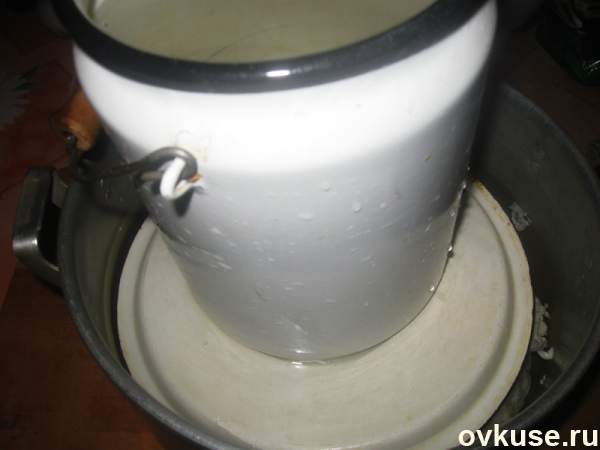
Gone are the days ... and the cabbage is slightly leavened. Make the final chord.
We need to cook the pickle. How much water to take is tested by practical consideration.
Cabbage should float in brine freely. Pour the required amount of water into the pot, add salt, red pepper, black pepper and bay leaf. We put on the fire and wait for the boil.
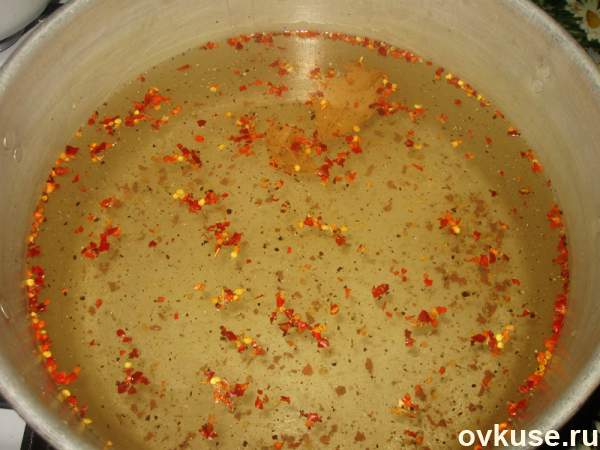
In the meantime, let's do cabbage and everything else. Drain water from cabbage and wash it well.
Putting it in a colander, on a grate or somewhere else, so that all the excess moisture in the glass. Peel the garlic and chop it finely.
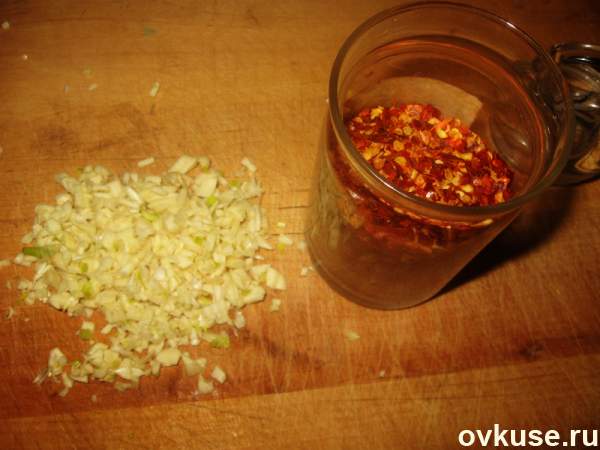
And chopped, mix with red hot pepper in some small pot.
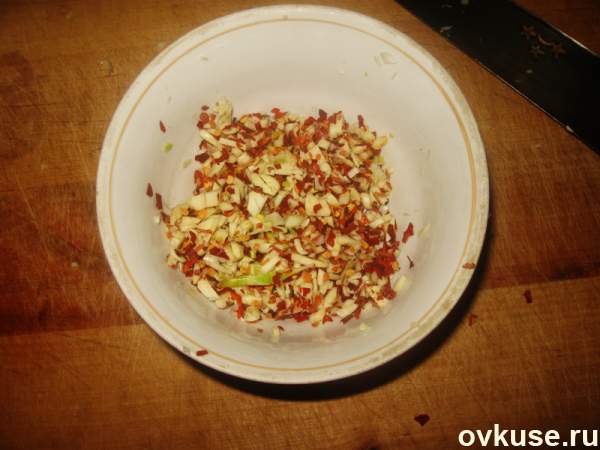
Now we take the cabbage quarters, which by this time is glass. We see that its leaves are spread out. This is what we will use and lay between the leaves of the lethal mixture that we have prepared.
![]()
The result was something like that.
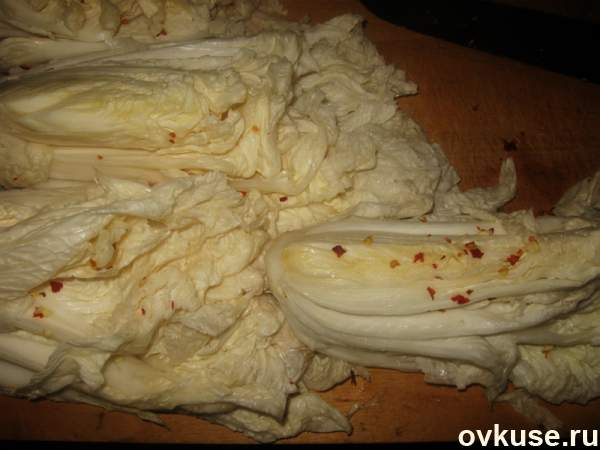
By this time, the brine is likely to boil. Our task is to put the cabbage in the same container in which it was, and pour boiling brine.
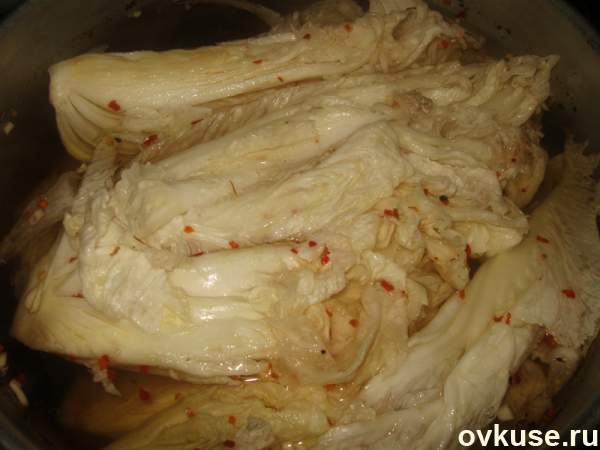
Cover with a lid and put in the same warm place for another day.
Well, a day has passed, and our fire snack is ready.
It can be laid out whole leaves or cut - all one.
Chim-cha perfectly goes as an addition to meat dishes; cold vodka is perfect for her.
If it seemed very hot, rinse. But it is for women. A man of sharpness is not afraid of traces.
It is tasty and good for the male body. I warn you, chim-cha will leave instantly. Just try.
In a Korean book about Korean cuisine, it says:
"More and more people in the world are becoming acquainted with Korean cuisine, discovering the wonders of our very specific vegetable, appetizing appetite dish - kimchi. If you ever try it, you can never refuse it."
I can not agree with this expression.
In general, for me a lot is connected with Korean cuisine. Because in childhood, adolescence, and now I have a lot of Korean friends. Their culture and life is close to me, and of course I am a big fan of Korean cuisine.
And today I want to introduce you to another dish of national Korean cuisine
Kimchi
Or, as it is called Tashkent Koreans - Chimchi.
Chimchi is pickled or salted vegetables. In this case, consider the example of Chinese salad. Here is another paradox - in Uzbekistan it is called Korean (Peking) cabbage :-)
So, a few forks of Peking cabbage are carefully washed, cut lengthwise into two parts, put into an enameled pan and plastic container, as I did, and fill it with salt water. How salty - it all depends on your taste. I diluted approximately in the following proportions - about 5-6 tablespoons of a slide for a 3-liter bottle of warm water.
We put oppression on top so that the cabbage is completely covered with water.
And we remove in a warm place for 5-6 days.
About a day before the end of this period, we take a lot of hot pepper, you can add pepper-chili
Grind it through a meat grinder or in a blender, add garlic
I draw your attention to the precautions - take care of your eyes, nose, mouth. In general, it is better to work with a large amount of pepper (especially when grinding in a blender) with gloves. I highly recommend it to you. Otherwise, a small furry northern animal will sneak up on you. Eyes can be burned as nothing to do.
So, grind, let stand for a day, put the juice.
Just by this time our cabbage will arrive in time - it will be salted.
Wash it with cold water, put on gloves again, and carefully, each leaflet, mix it with a mixture of ground pepper and garlic.
Fill it with warm salt water again, set the oppression from above, and put it in a warm place for a day or two.
After that, you can decompose chimchi on banks or another, more convenient container, and put it in the fridge.
Use as needed - as a salad, as a snack, as a cure for colds.
Yes, yes, you heard right. Just like medicine. For the remarkable properties of kimchi (chimchi) are recognized in the world, in this dish the taste and nutritional properties of the original products are well preserved. In the process of creating kimchi, many beneficial microorganisms are involved, for example, lactic acid bacteria. They determine its beneficial effects on the human body, the mechanism of which is not fully disclosed until now. It is known that kimchi contributes to the resorption of fatty deposits and cleansing the brain, has a beneficial effect on the intestines, prevents aging.
Use of this material is possible only with the written permission of the author.
Usually Koreans make kimchi from Chinese cabbage, which we grow little. But Korean cuisine is so good that it easily adapts to the available products. And in this recipe, I will tell you how to make a popular Korean kimchi snack from one of the most common vegetables in Russia - white cabbage.
Unlike Chinese cabbage, for the ferment of which, when cooking real kimchi, you need to add special ingredients (rice flour, salted squid or other seafood) and take certain actions (cooking porridge ferment from rice flour and sugar), our cabbage sour itself well .
Plus, white cabbage is much cheaper and more common than its Asian congener. And of course, the taste of our native vegetable is more familiar to us. Try to make this simple and inexpensive dish, do not deny yourself the pleasure of crunching spicy cabbage.
All the seasonings for this recipe can be bought at almost any store, and vegetables can be taken from the garden. Nothing specifically to look for and grow do not have to.
![]()
White cabbage ~ 1 kg
1 medium carrot
1 small bunch of green onions
3-5 cloves of garlic
1.5 Art. spoons of fish sauce (can be replaced with soy)
2 tbsp. spoons of soy sauce
1 tsp sugar
1 tbsp. spoon of hot pepper flakes
1 tbsp. spoon dry ground paprika
For brine:
3 tbsp. spoons (75 g) of salt
1 cup of cold water
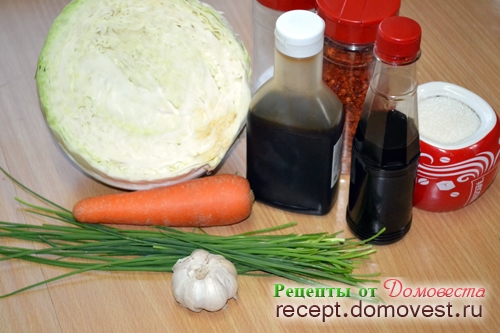
As you can see all the most ordinary products with the exception of fish sauce. Instead, you can use oyster, which is more often in our stores. Or especially not to bother, and replace with the soy sauce that has already become familiar to us.
I put some chili pepper flakes a bit, and for the color I added ground paprika. Koreans usually put three to five times more red hot pepper. So, if you love as keenly as in Korea, feel free to pour a third of this seasoning into the seasoning. Then do not put paprika.
If there is no pepper flakes, it can be replaced with powdered, just take it smaller, it is more spicy.
First of all, we shred the whole cabbage a little larger than our Russian fermentation. That is, straws with a width of 0.5–7 cm and a length of 5–7 cm.

Fall asleep with salt, slightly mnem, pour water, mix. Set aside for half an hour, salted. Water is drained. We try. Cabbage should be salted like a salad. If we feel that cabbage, namely cabbage, and not the water remaining on it, is salted enough or much, wash the cabbage straw with cold water. And if it turned out to be under-salted, add salt to taste and mix.
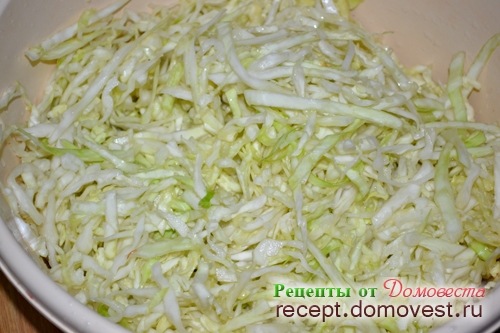
In the meantime, the cabbage is salted, we will prepare a dressing, which is actually called kimchi. Shaving carrots fine straws. Onion chop diagonally. Chop the garlic with a knife. Put all the vegetables in the cup. We pour pepper, paprika and sugar. Pour fish and soy sauces. Well, or one soy, if not available fish.
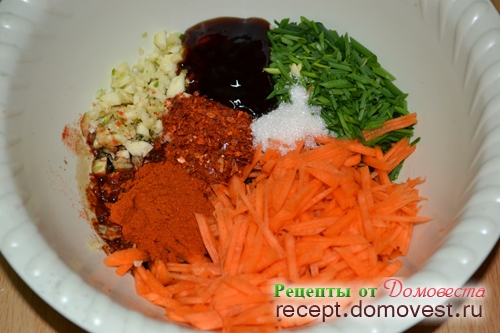
All this is well mixed. Not necessarily with chopsticks, but it's really more convenient to interfere with them.

